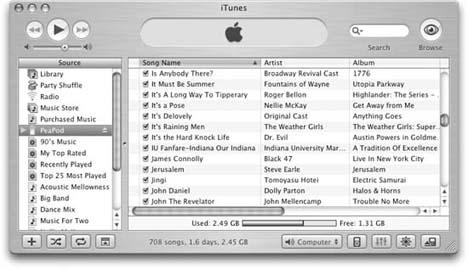Varying the Auto-Transfer Theme
The beauty of the iTunes/iPod system is that whatever music you add to your Mac or PC gets added to the iPod automatically, effortlessly, quickly. You’ve always got your entire music collection with you. Just plugging in the iPod inspires iTunes to open up and begin syncing.

Figure 2-7. The Source list (left side) displays an icon for the iPod whenever it’s connected and a handy Eject button right next to it, as well as your music library, list of playlists, songs from the iTunes Music Store, and Internet radio stations. The bottom of the window shows the amount of space left on the iPod, the number of songs, and the consecutive days the iPod can play music without repeating songs.
It’s conceivable, however, that you won’t always want complete and automatic syncing to take place whenever you connect the ‘Pod. Maybe you use the iPod primarily as an external hard drive (Chapter 12), so you don’t especially care to have iTunes jumping up like a West Highland terrier every time you plug in the iPod. Maybe you want to synchronize only some of your music, not all of it.
Fortunately, you’re in complete control of the situation.
Stop Auto-Opening iTunes
If you like, you can command your jukebox software to open only when you want it to, rather than every time the iPod is plugged in. Just open iTunes, plug in the iPod, and, in the Source list, click its icon.
Get iPod and iTunes: The Missing Manual, Third Edition now with the O’Reilly learning platform.
O’Reilly members experience books, live events, courses curated by job role, and more from O’Reilly and nearly 200 top publishers.

